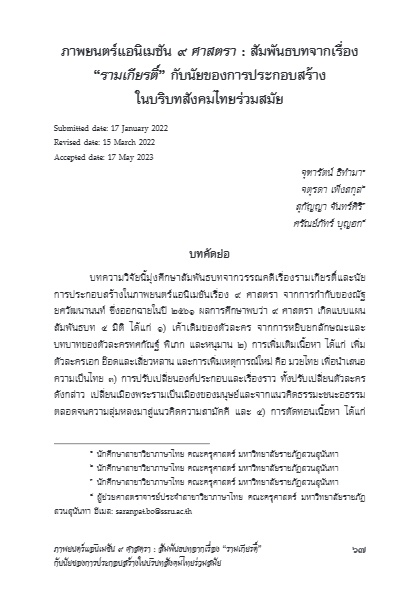ภาพยนตร์แอนิเมชัน ๙ ศาสตรา : สัมพันธบทจากเรื่อง “รามเกียรติ์” กับนัยของการประกอบสร้างในบริบทสังคมไทยร่วมสมัย
จุฑารัตน์ ธิทำมา
จตุรดา เพ็งสกุล
สุกัญญา จันทร์ศิริ
ศรัณย์ภัทร์ บุญฮก
บทคัดย่อ
บทความวิจัยนี้มุ่งศึกษาสัมพันธบทจากวรรณคดีเรื่องรามเกียรติ์และนัยการประกอบสร้างในภาพยนตร์แอนิเมชันเรื่อง ๙ ศาสตรา จากการกำกับของณัฐยศวัฒนานนท์ ซึ่งออกฉายในปี ๒๕๖๑ ผลการศึกษาพบว่า ๙ ศาสตรา เกิดแบบแผนสัมพันธบท ๔ มิติ ได้แก่ ๑) เค้าเดิมของตัวละคร จากการหยิบยกลักษณะและบทบาทของตัวละครทศกัณฐ์ พิเภก และหนุมาน ๒) การเพิ่มเติมเนื้อหา ได้แก่ เพิ่มตัวละครเอก อ๊อดและเสี่ยวหลาน และการเพิ่มเหตุการณ์ใหม่ คือ มวยไทย เพื่อนำเสนอความเป็นไทย ๓) การปรับเปลี่ยนองค์ประกอบและเรื่องราว ทั้งปรับเปลี่ยนตัวละครดังกล่าว เปลี่ยนเมืองพระรามเป็นเมืองของมนุษย์และจากแนวคิดธรรมะชนะอธรรมตลอดจนความลุ่มหลงมาสู่แนวคิดความสามัคคี และ ๔) การตัดทอนเนื้อหา ได้แก่ ตัดทอนพระราม และตัดทอนลักษณะนิสัยความลุ่มหลงในอิสตรีของทศกัณฐ์เพื่อขับเน้นความสมานฉันท์ สัมพันธบทแสดงนัยที่สัมพันธ์กับบริบทสังคมไทยร่วมสมัยประการแรก สะท้อนความแตกแยกทางการเมืองไทย จึงทำให้ภาพยนตร์ดัดแปลงเรื่องราวมาสู่แนวคิดเรื่องความสามัคคีและสมานฉันท์ แทนการสงครามดังเช่นในอดีตอีกประการหนึ่ง คือ อิทธิพลของกระแสโลกาภิวัตน์กับการแสดงความเป็นไทย ด้านหนึ่งภาพยนตร์เป็นผลพวงของการเน้นย้ำและเผยแพร่ “ความเป็นไทย” แต่อีกด้านหนึ่งภาพยนตร์ก็แสดงให้เห็นความเป็นไทยที่มีการผสมผสานกับวัฒนธรรมและสื่อนานาชาติท่ามกลางกระแสโลกาภิวัตน์
คำสำคัญ: ๙ ศาสตรา, สัมพันธบท, รามเกียรติ์, ความเป็นไทย, สังคมไทยร่วมสมัย
(ตีพิมพ์ใน วารสารไทยศึกษา ปีที่ 19 ฉบับที่ 1 (มิถุนายน 2566) หน้า 67-101)
The Legend of Muay Thai: 9 Satra :Intertextuality from Ramakien and Implications of the Film’s Construction in Contemporary Thai Society
Jutharat Thithamma
Jaturada Pengsakul
Sukanya Jansiri
Saranpat Boonhok
Abstract
The research for this article aimed to study the Thai animated film ‘The Legend of Muay Thai: 9 Satra’, directed by Nat Yoswatananont and released in 2018, under two main objectives. The first objective was to study the intertextuality of Ramakien, a Thai rendition of Ramayana, in this film; secondly, the implication of that intertextuality of Ramakien constructed in this film was examined along with the Thai contemporary context during the 2010s. The results of the research are that there are four types of intertextuality from Ramakien in this film. Firstly, the characteristics and roles of the main characters from Ramakien, Thotsakan, Phiphek and Hanuman, remained. Secondly, these characters were transformed in many ways. The setting of Ayodhya, or Rama’s city, as well as the battle of good, evil and delusion, were adapted to serve as a new theme of unity. Thirdly, the film added new characters, Ot and Siao-lan, along with a new feature, Muay Thai, to present Thainess. Lastly, key aspects, such as Phra Ram and the delusional nature of Thotsakan in women, are omitted in this film to emphasise social unity rather than war. These findings link to two main contexts during the 2010s in Thai society. First and foremost, this film resonated with the political conflict and polarization in Thai society. Rather than focusing on the battle of the opposing sides, the main theme of this story aimed to call for unity and concluded with friendship. Finally, The Legend of Muay Thai: 9 Satra depicted the impact of globalization that challenges Thainess. On the one hand, this film might be seen as a consequence of the anti-globalization movement insofar as the film returned Thainess to the screen. On the other hand, the film shows the status of Thainess that has to be hybridized with international cultures and media.
Keywords: The Legend of Muay Thai: 9 Satra, Intertextuality, Ramakien, Thainess, Contemporary Thai Society
(Published in Journal of Thai Studies Volume 19 Number 1 (June 2023) Page 67-101)
บทความ/ fulltext : 3_Jutharat.pdf
